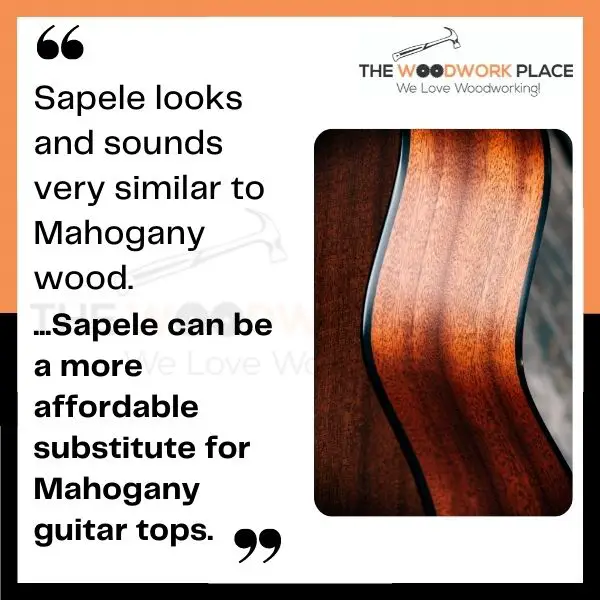It can take over a month to build your own handcrafted guitar. And, what you absolutely don’t need, is to realise (after the fact) that you didn’t choose the very best type of wood for your fretboard.
So, in this post, you will discover exactly what Sapele wood is, and why this reddish-brown hardwood makes for such great fretboard material. Let’s get into it…

This post may contain affiliate links to products that we receive a commission for (at no additional cost to you). Learn more here.
What Is Sapele Wood Like?
Sapele wood is very much like Mahogany. And the reason for this is because they both belong to the same tree family.
The Mahogany wood we’re familiar with in the USA and Canada, comes from Southern America. Also referred to as Genuine Mahogany, this rich brown lumber is highly prized, and it thrives in tropical rainforests.
However, Sapele wood grows abundantly across West Africa. As a harder version of Mahogany wood, it is used to make solid wooden doors and hardwood floors.
Related Post: Deciding Between Poplar Vs Mahogany Wood For Your Guitar
And Is Sapele A Good Tonewood?
Overall, to the trained ear, Sapele sounds very much like Mahogany wood. Which means it produces a great mid-range tone.
Sapele wood tends to be used to make guitar necks, not the soundboard (which is the part of the guitar where tonewood has the most noticeable effect on sound quality). However, you can substitute Sapele for Mahogany when it comes to making guitar tops too.
Yet, Mahogany’s rarely used for making Fretboards, as this wood is too soft for this section of the guitar.
But, based on the Janka Hardness scale, Sapele is much harder than Mahogany. Hard enough, in fact, that Sapele can be used for your fretboard.
What Is The Janka Hardness Scale?
This scale gives us a handy measure of the density of any given wood species. The higher the Janka rating, the more pounds of force it takes to dent a piece of wood.
And the more force it takes to dent a piece of wood, the harder the lumber.

But, Why Does The Hardness Of Fretboards Matter?
Fretboards are cut pretty thin. So, the wood they’re cut from needs to be naturally hard enough to handle the relentless finger pressure put upon it.
Maple wood, (a poplar and affordable fretboard wood), has a Janka rating of 1450 lbf. Which means that this hardwood won’t crack until you apply 1450 pounds of pressure (or more) on it. And Rosewood, (an expensive but top quality fretboard material), has a Janka rating of 1780 lbf.
However, Mahogany sits very low on the Janka hardness scale with a fairly soft 900 lbf rating. While Sapele wood is nearly twice as hard as Mahogany wood, (and a touch tougher than Maple), with a Janka rating of 1500 lbf.
So, (unlike Mahogany), Sapele would make a good choice for fretboards too.
Is That The Only Reason Why Sapele Is Better Than Maple?
No, not at all. Another advantage Sapele has over Maple, is that it is more durable than Maple wood. You see, Maple isn’t a naturally durable wood (if its left unfinished).
Instead, the type of Maple wood used to make unfinished fretboards, is what’s referred to as Roasted Maple. This specially treated version of Maple wood has been put through a super-heated process. This treatment makes Roasted Maple more stable, and in turn, less likely to form little fine cracks on its surface.
However, Sapele is so naturally durable that it is rated as a Class 1 wood. This means that Sapele is rot-resistant, very stable, and can even be used to make outdoor structures. Basically, it has a similar level of durability to Rosewood.
So, a Sapele fretboard makes for a fantastic, (and more cost effective), alternative to a Rosewood or Ebony fretboard.
To Wrap Up, Here Are The 3 Key Takeaways From This Post…
- 1). Sapele looks and sounds very similar to Mahogany wood. That’s because they both belong to the same tree family.
- 2). Sapele can be a more affordable substitute for Mahogany guitar tops.
- 3). Unlike Mahogany, Sapele wood is hard enough to be used as fretboard material.

